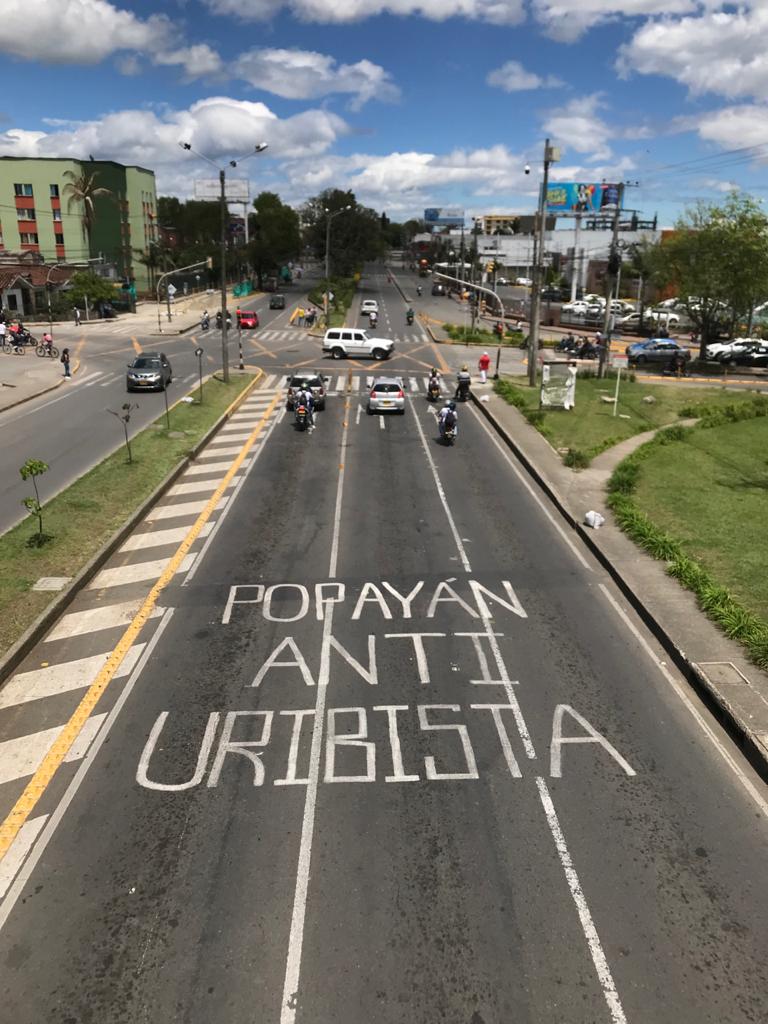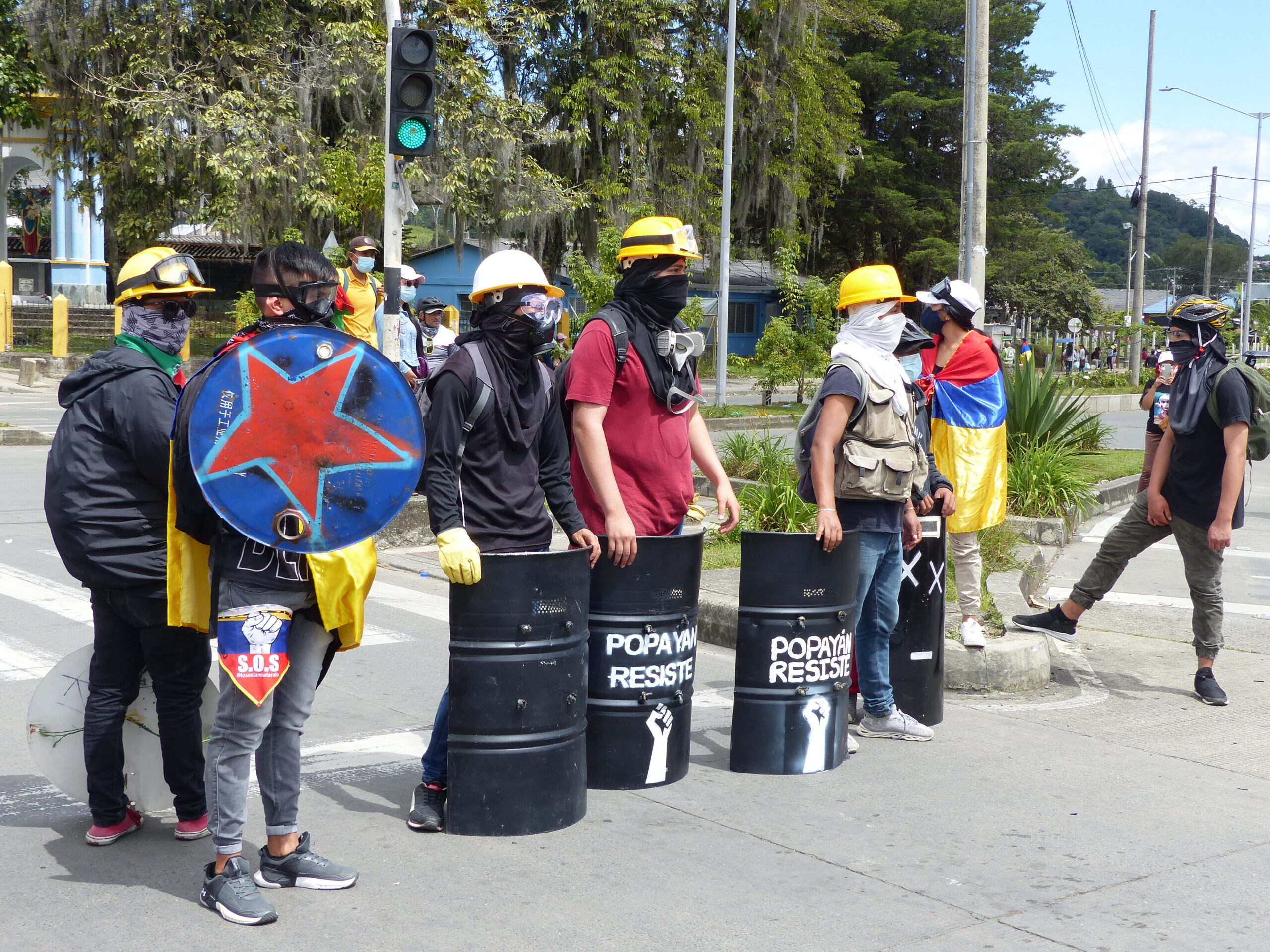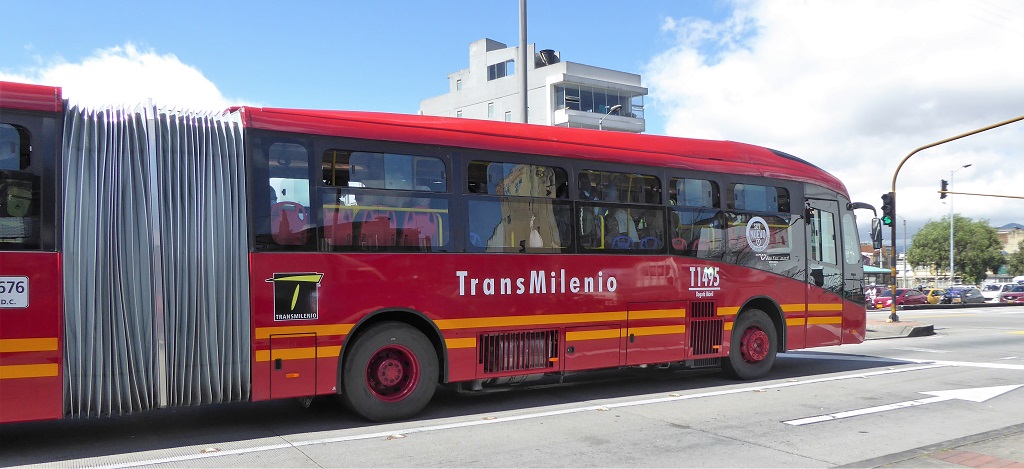Protestors nationwide mobilized on July 20, Colombia’s Independence Day, to show continued support for the ongoing “Paro Nacional” [National Protests], as well as voice their discontent with the government’s pandemic response, the lack of economic opportunities and police brutality during the protests.
In the capital city of Colombia’s southwestern Cauca Department, Popayán, indigenous organizations and labor unions marched in two main groups across town, hoisting banners and chanting slogans. The marches were mostly peaceful, however, by nightfall there were some clashes with police and 11 people were reportedly injured.
Seated at a cafe near a roundabout where protestors were supposed to pass by, I was joined by Laura Jaramillo, an ornithologist and anthropologist with the Fundación Munda Mujer in Cauca, who was tracking the progress of the marches on social media and via text messages with friends.
While we waited for the protesters to turn up, across the street we noticed a line of bright green police motorcycles and officers in dark green uniforms sipping coffee, also awaiting the day’s action. Foregrounding the scene was a lady loudly selling “avocados!” from a roadside cart.
“That’s pretty good because ‘aguacate’ [avocado] is what everyone yells at the police,” Jaramillo quipped. “AGUACATE!”

Speaking about the motives behind the protests, Jaramillo said resting her face in her palms, “Nobody really knows what the protests are about. But there is no opportunity for them to work, to study, the violence … It’s mainly poverty. It’s so many things.”
The original plan was for the protestors to snake through town along two main routes and join up at Popayán’s main commercial center, a shopping mall called Campanario, located on the Pan American highway. From there, the march would move towards downtown Popayán. Laura received a text message from one of her colleagues who was marching with the group to the south.
“They changed the route to avoid the police. Come on, we have to walk,” she said.

Walking on a pedestrian bridge crossing the Pan-American Highway a few minutes later, we see that the road leading into the intersection adjacent to the mall is graffitied with big block-letters reading: “POPAYÁN ANTI URIBISTA,” a proclamation against former President Alvaro Uribe, the political patron of current President Duque. It’s one of many anti-Uribe and anti-Duque slogans painted on walls and streets throughout Popayán.
Just then, a “chiva” [a large open-air bus] loaded to the roof with Nasa protestors roars past followed by a motorcycle bearing a large amplifier playing indigenous music at a level that must’ve been deafening for the driver; the frayed Colombian flag staked to the rear of his bike was flying upside down. The Nasa people are the largest indigenous group in Colombia and they’ve had a big presence at protests in Popayán and Cali and as far away as Bogotá.
The new route the march will take is along Carrera 6 which is a short walk through a sleepy residential neighborhood with Colombian flags hanging from the balconies and framed in the windows. When we arrive on Carrera 6, shop shutters are slamming shut along the commercial corridor. Across the street, there’s a large park called Parque Principal Villa Docente.
A Vietnam-era Huey helicopter lops along overhead playing a pre-recorded female government voice over its apocalypse-now loudspeakers. There are machine guns mounted in the open side doors, and a gunner in dark glasses looks down as the craft banks beyond the treeline. The recording urged protestors to peacefully finish their demonstrations and return home before the 4:00 PM government curfew.
The street clears out soon after. Shop doors shutter closed. From the second and third stories, people peer through barred windows at the mostly empty street. From down the road, horns can be heard. The plastic bleat of football-crowd vuvuzelas intermingled amidst the staccato fireworks snap of a drumline.

When viewed down the fully zoomed-in lens of a digital camera, details of the individual marchers assemble out of the low ripple of mirage blanketing the bare street in a hot swathe of steady visual distortion.
Within a few minutes, the march has advanced towards the park and it’s obvious that this is a peaceful and coordinated effort. The front line of protestors dons Mad Max counter-riot gear to serve as a Napoleonic-warfare style human shield to children waving flags and flautists, and people dancing behind them.
The march was broken up into segments of about 400 protestors, and at the beginning of each new segment was a ‘front-line’ of young people wearing homemade riot gear. As each new front-line passed demarcating the beginning of each new segment of the protest, those watching from the sidelines broke into applause for the young people at the front. It’s the frontline’s job to protect all of those behind them with their makeshift shields, even when the police switch from rubber bullets to live rounds.
As they march, the protestors chant. One of the most popular chants of the afternoon has to do with Cauca’s continued disdain for ex-president Uribe.
¡A parar para avancar!
¡Waoooooo!
¡Que, que!
¡Estop!
¡Uribe paraco hijueputa!
Set to the rhythm of La Gente Pesada’s salsa choke song Cucha Cucha.
Strike to advance!
Woaaaahhh!
What, what?
Stop!
Uribe is a paramilitary son of a bitch!
At least one protester marched by draped in the soviet-era hammer and sickle flag, and many of the slogans painted on the homemade riot shields and plywood signs reflected a violent left-wing ambivalence towards the current state of political affairs. This included:
- A fist painted like a Colombian flag framed in the slogan: “PODER POPULAR.”
- A Colombian flag painted with the words: “MARCHAMOS JUNTOS, VOLVEMOS JUNTOS.”
- And homemade riot shields emblazoned with law-enforcement provoking: “A.C.A.B.” and “ANTI-TOMBO” and “PRIMERA LINA.”
Trucks and cars rolled along with the crowd decorated in banners and flags with their stereos turned up to top volume, playing Campesino, indigenous, protest, cumbia, salsa choke, and chirimía music. The streets were filled with people with gas masks around their necks, dancing, and many children were present. Campesino women in traditional dresses danced a few lines ahead of native bands playing traditional Andean music, who marched a few lines ahead of a pickup truck people that about forty dancers had formed a daisy chain around, and were all running and laughing to the happy music playing over the loudspeaker.
The march from the south must’ve numbered around 3,000 people and it took more than an hour for the procession to move past the park.
The march from the north met the march from the south at the intersection of Carrera 6 and 25 Norte. A band playing traditional music called ‘La Gran Banda Chirimera’ marched along with panpipes, dancers, and drummers. It was at this juncture that Jaramillo’s friend, Rosanna Buscamante, arrived wearing a red and green flag, and bright red shoes to match.
Buscamante teaches “Buen Vivir” [Good Living] at the Autonomous Indigenous Intercultural University (UAIIN) in the city, and is a member of Consejo Regional Indígena Del Cauca (CRIC), one of the most powerful indigenous organizations in the country. Her red and green flag is a symbol of the movement with green representing hope and life-plans, and red representing the blood of their elders that has been spilled.
Her course teaches indigenous students about their “native language, geography, plants and animals, their spiritual beliefs, and about how to create the best spiritual, physical, and mental health of their community,” Buscamante said.
“It allows them to fight against the sugarcane plantations,” she explained further. “The haciendas are demolishing the Nasa’s ancestral land. They have been fighting for years to stop the expansion of the plantations.”
Buscamante is the only ecologist in the university and her class has a strong focus on teaching about revitalization efforts of “Kiwe Uma,” which translates literally to, “Earth Mama,” and help create economic opportunities for young people. Right now, there are few such opportunities in Popayán.
Before the pandemic, Popayán had the fourth-highest youth unemployment in Colombia with one in three young people between the ages of 14 and 28 unable to find work. The pandemic has only exacerbated the issue, and that is viewed to be one of the driving forces behind why so many young people are taking to the streets to protest.

On a street with hundreds of protestors, a woman with a septum piercing stood chanting “¡Vive Paro Nacional!” [Long live the national protests]. She asked not to be photographed and used the pseudonym “Cactus,” but offered to explain what she thought the Paro Nacional was about and why she thinks young people, in general, are protesting.
“I think the Paro Nacional is pretty linked to the mismanagement of the world pandemic. The government took out money to help with the pandemic but no university, no observatory, no entity outside the government has knowledge of how that money was spent and I think that’s problematic,” she said.
Cactus thinks that the young front-line of the protests have been by and large cast aside from the organizers of the marches who once fed them and provided them with supplies and transportation.
“What we call ‘Primera Lina’ [front line protestors], they have been the ones resisting in the streets,” Cactus explained. “They have had pretty violent encounters with the police and I think that comes from two things: One, the anger; and two the lack of fear. They have been transmitting these encounters with the police through social media, Instagram, Twitter, and they’ve been sleeping in public parks. But time keeps going and the national strike loses its strength. These young people who were called the front line have been left behind,” she lamented.
For the rest of the day, Cactus’ words added some weight to the applause and cheers that rang out as each new segment of the march passed by.
At 3:00 PM the protests entered downtown and reports came in from Twitter and over text message that the police were beginning to attack protestors. Popayán was set to go on lockdown at 4:00 PM, and the march took a turn into a neighborhood that Jaramarillo said wasn’t a good one to be in if the police were to start an attack. Buscamante decided to go home, too.












